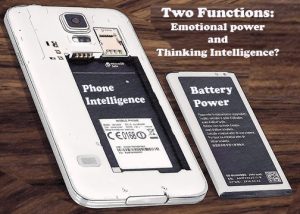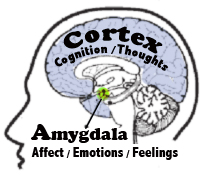Emotions or Thoughts?
Unexpressed emotions will never die.
They are buried alive and
will come forth later in uglier ways.
Sigmund Freud
Batteries don’t make phone calls.
But without out battery power,
phones don’t make calls either.
Daynjoor Kieu
I’m emotional and that’s okay. I’m depressed and that’s okay. I’m angry and that’s okay.
I’m worthless and that’s okay. I’m bad and that’s okay. I’m overwhelmed and that’s okay.
Wait! Stop!!! Hold on a moment!
Worthless, bad and overwhelmed are not emotions. They are thoughts. They may not be okay. They may not even be healthy, functional and empowering.
Thoughts and emotions are very different things. And yet, as different as power is from direction and emotions are from thoughts, we constantly confuse them. We struggle to see our emotional power as distinct from our thinking direction or intelligent guidance and our acting out.
All emotions are okay because they just give us power without guidance or direction. We can not stop our emotions. Emotions will happen whether we want them too or not, just like breathing, sleeping and going to the bathroom. What we can do is build awareness and skills to regulate and harness our innate emotional power. We can learn ways to reduce or change how we generate our emotions in the first place. We are born emotional so all emotions are okay. Emotions just give us power.
But thoughts give us direction. Thoughts give us guidance. Thoughts we have to learn and are not innate. We are not born smart. Thoughts are not power, but are powerful by harnessing our emotional power or even by providing a spark that creates an emotional explosion. Our emotional power cannot be expressed without thoughts or actions, even if at a subconscious level.
So, how can two very different things – emotions and thoughts – be so easy to confuse?
Here are four ways to help clarify the differences 1) cell phone, 2) Brain structure, 3) visual pic 4) car analogy. The goal is to learn to easily recognize the difference between thoughts and feelings. To be mindful of your emotional power and thoughtful directions and actions.
1) A phone analogy to recognize power from direction; emotions from thoughts.

If you take the battery out of the phone, what can it do? If you let your phone’s battery run down to nothing, and the battery is dead, what can the phone do? It is useless. It is dead. It has no power.
If you just have a battery, what can it do? A battery just gives power, but without the power, nothing happens next. The battery power is absolutely essential, yet it doesn’t make a call. It doesn’t text or search the web. They battery just gives power. So having a battery is okay. Having a fully charged battery in our phone is okay. In fact, I think a fully charged phone battery is awesome. A full battery is great.
But, who you call and text or what you type, say or search for can be good or bad, helpful or hurtful. How we use the phone is not always okay. It’s good to call a friend, but bad to call an enemy. Not helpful to call a wrong numbers. Or pocket dial a stranger. How we use the phone is not always okay. But having a powered battery in the phone is always okay.
2) How our brain creates emotions and thoughts is different. Very different.

The amygdala is the emotional center of our brain. The amygdala is the battery of our brain, and as such, it is the first thing in our brain that is fully developed. I would even suggest that our life starts when the amygdala battery is charged with our first emotional power experience. But that is another discussion for another time. However, the amygdala is fully developed and hard wired when we are born. Our emotions are innate and ready to feel. Emotions don’t have to be learned. We are born with a fully charged emotional battery.
The cortex is the thinking center of our brain. Like a brand new phone, it has some limited abilities but not much. The cortex is mostly undeveloped at birth, practically a blank slate or tabula rasa. In fact, it takes 2 years just to be wired well enough to work properly [fully myelinated] and 25 years to be fully wired and developed. Thoughts are not innate. We have to work to learn. We create the thoughts in our head. Over our life, we down load a lot of brain apps into our cortex.
3) The circles of our life are emotional power, intelligent choices and Actions. Each circle is unique and different, but also essential to our life.

Emotional power gives us energy to think and act in whatever way we choose. Emotional power is unconditional. It will power anything good or bad, healthy or unhealthy, respectful or disrespectful. Emotional power doesn’t provide guidance, insights or direction. And while sometimes we have more power than we know how to handle, it is our inability or lack of skills to handle the power that is the problem. All emotions are okay. All emotional power is natural and normal. We’re emotional and that’s okay.
Intelligence provides the guidance and direction in our lives. Intelligence is way more complicated, comprehensive and intricate than we are often aware. We have memory intelligence, values, beliefs, judgments, intuition, hunches and neuroception. We have intelligence skills that are subconscious and pre-conscious and even built into our neurological brain processes that we have created through habit and experiences. Our intelligent abilities are so awesome that they can create our vision of reality. However, not all visions are healthy, respectful and empowering. Some visions are violent, unhealthy, invalidating and destructive. Not all intelligent insights, choices and directions are okay.
Actions are the movements of our life. Our behaviors reflect and express our inner choices powered by our emotional energies. Behaviors, like intelligence, can be positive or negative, empowering or destructive. Not all behaviors are okay, as they can be positive or negative, creative or destructive.
In our lives, we chose our thoughts and behaviors as they are not automatic or innate. We are not driven by instincts, but have a choice of how we will think and act. Emotions are automatic and innate and often just happen without our conscious effort. However, our emotional powers can be triggered by our thoughts or actions, as well as the world around us.
4) The car analogy is seeing how car functions are like our own functions. Gasoline gives the car power and is similar to our emotional power. Steering directs the car and is similar to our thinking. Tires move the car and are similar to our actions. So, gasoline, steering and rolling are distinct and separate functions of a car, just like emotions, thoughts and actions are distinct and separate functions of ourselves.

So, if you drove the car and crashed into a tree, would you blame the gasoline? Of course, not. the crash was either steering or speed issues or maybe even road conditions. You wouldn’t say, “I had gas in the tank, which cause me to crash into a tree.” People would think you lacked common sense. But, if we switch from a car perspective to a person perspective, “I hit that person because I was angry.” Now it seems okay to blame the anger, which is just like blaming the gasoline. However, if anger really made people hit someone else, then every time we got angry we would hit someone. That doesn’t happen. Most people have skills to manage our angry power in a more healthy and respectful way. It is our lack of skills or difficult situations that cause us to lose control, but the anger is not to blame anymore than the gasoline is if we drive the car into a tree.
This brings us back to the first step, how to realize that we are emotional beings. That we are hardwired to have emotions automatically because they just give us power to live our life. All emotions are okay.
The challenge is to recognize what we are thinking and doing and feeling. To recognize each without mixing them together. And, to recognize each even when we do mix them together.
It seems pretty easy to see the difference related to a phone and battery; a brain’s amygdala or cortex; the circles of life – emotional expression, thinking choices and movement chosen; or a car’s gas, steering and wheels. It’s time to start seeing the difference of emotions versus thoughts or actions in our own life.
I’m emotional and that’s okay. I’m depressed and that’s okay. I’m worthless and that’s okay.
Wait, I’m not worthless, that is a thought. I’m sad thinking that I am worthless, and feeling sad is okay. Thinking I am worthless is not okay and I need to challenge and change that negative thinking. I sometimes act like I am worthless, and those actions are not okay. I need to recognize my worth and respectfully take actions to stand up for myself.
So, we start by saying “I’m emotional and that’s okay.” and can now add, “And that is how I feel.” Or, “And that is a thought.” Or even is some cases, “Wait, that is not a feelings, it is a thought.”
I’m anxious and that’s okay. Anxious is a feeling.
I feel insignificant and that’s okay. Wait, insignificant is a thought. I’m more important than that. It’s okay if I feel sad and angry when I’m thinking I don’t count. I need to change my thinking because I do count.
And so it begins, the intentional steps of change to improve the quality of our life. Step one – all emotions are okay. Step two – I can clearly see the difference between thoughts and feelings.
Are you ready for step three

Pingback: The BCA Outlook: #1 - Emotional Powers